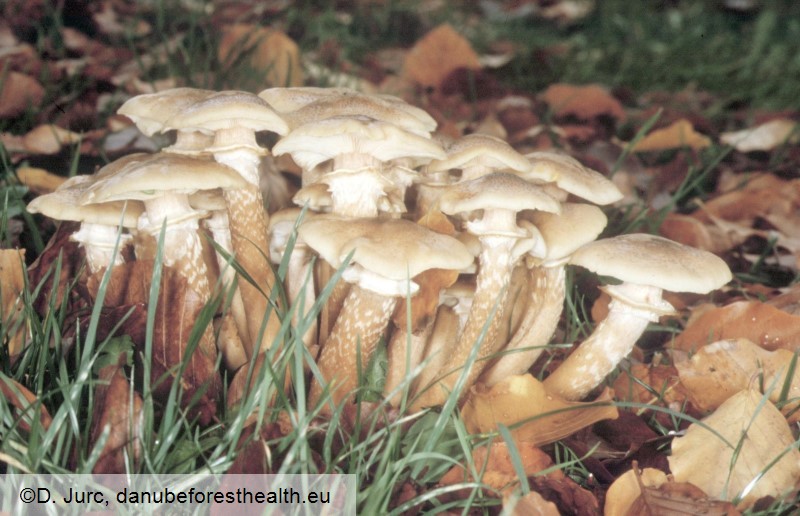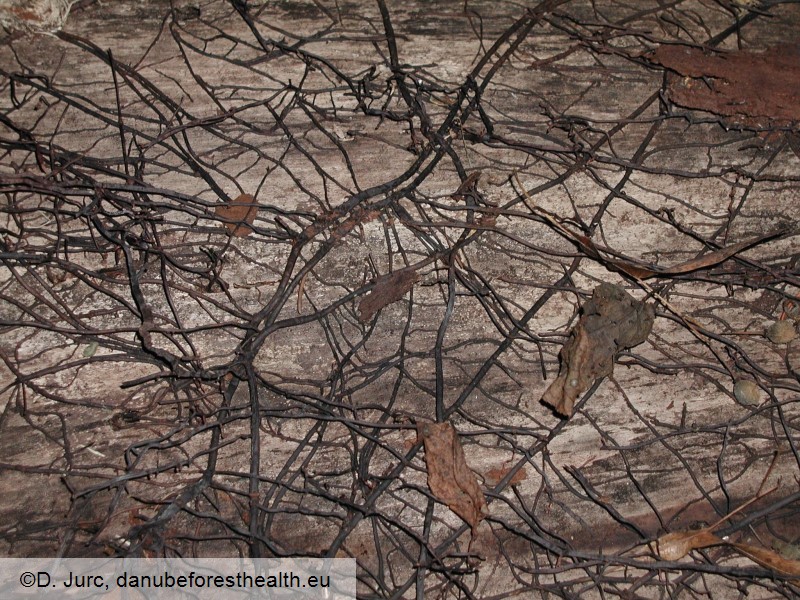Fungi
Honey fungus
Armillaria spp.
Nikica Ogris, Thomas Cech
|
|

Fig. 1. Typical fruiting bodies growing in groups, usually near or from the stump

Fig. 2. Dense white mycelial fans are killing the cambium

Fig. 3. Mycelial strands (rhizomorphs) under the bark
DETECTION PERIOD:
by fruiting-bodies from (May) June to October (December), by mycelial fans and rhizomorphs during the whole year
DESCRIPTION:
The genus Armillaria comprises five species in Europe: A. mellea, A. ostoyae, A. borealis, A. cepistipes, A. gallica. Distinguishing the five species with high confidence in the field is difficult.
A quite sufficient proof of the presence of Armillaria are its fruiting bodies, which can be found on dead stumps or at root buttresses (Fig. 1). The fruiting body consists of a ringed stem surmounted by a usually domed cap, 5–15 cm in diameter. It can be any kind of honey colour from yellow or brownish to olive. The top of the cap bears dark, appressed flakes in its centre, which vary in prominence between the species. The stipe is provided with a filamentous, membranate or woolly thick ring. On the underside are radially arranged gills of bright white, later reddish-brown spotted colour, whose surfaces are covered with basidia. The spore print colour is white.
Evidence of the presence of honey fungus is provided by the white mycelial fans which occur at the stem base between bark and wood (Fig. 2). Also, heavy resin bleeding at the base of young conifers indicates an infection by honey fungus. Another sign are the rhizomorphs under the bark and in the vicinity of the roots (Fig. 3). They are typically dark-coloured, elastic strands, 1–2 mm across. The rhizomorphs can grow through the soil from tree to tree with the role of nutrients translocations and they can play a role in the infection.
The fungus can cause also a white rot. The decay is usually confined to the roots and the stem base (butt rot).
HABITAT:
Broadleaved and coniferous trees. A. ostoyae infects predominantly conifers, A. mellea infects predominantly broadleaves.
STATUS:
Honey fungus is among the most important tree pathogens, having a worldwide distribution in both forests and non-forests habitats and is able to infect almost all species of broadleaves and conifers.
IMPACT:
Although there are differences in aggressiveness among the species - A. mellea and A. ostoyae are often regarded as highly pathogenic - all Armillaria species are able to cause epidemics under appropriate conditions. The main predisposition factor is a disorder in the water regime of a host plant; other stress factors are pests, nutrient imbalances, sunburn or disorders by inappropriate planting).
SIMILAR SPECIES:
Gymnopus fusipes causes damage to roots and bark and a butt rot in oak. Fruit bodies are in fascicles at the base of stems and dark reddish brown with a furrowed or grooved and often twisted stem (Fig. 4).
Pholiota squarrosa is a root parasite and cause of white rot in the lower stem of number of broadleaves. Fruit bodies are at the stem base in fascicles, they are rusty yellow, and cap and stem are covered with shaggy, squarrose, recurved reddish brown scales (Fig. 5). The spore print is brown.
Pholiota populnea is a parasite on living and freshly felled stems of poplars causing a white rot. Fruit bodies are tough, wood-coloured, with the edge of the cap persistently rolled in. Cap and stem have white, evanescent scales (Fig. 6).
|